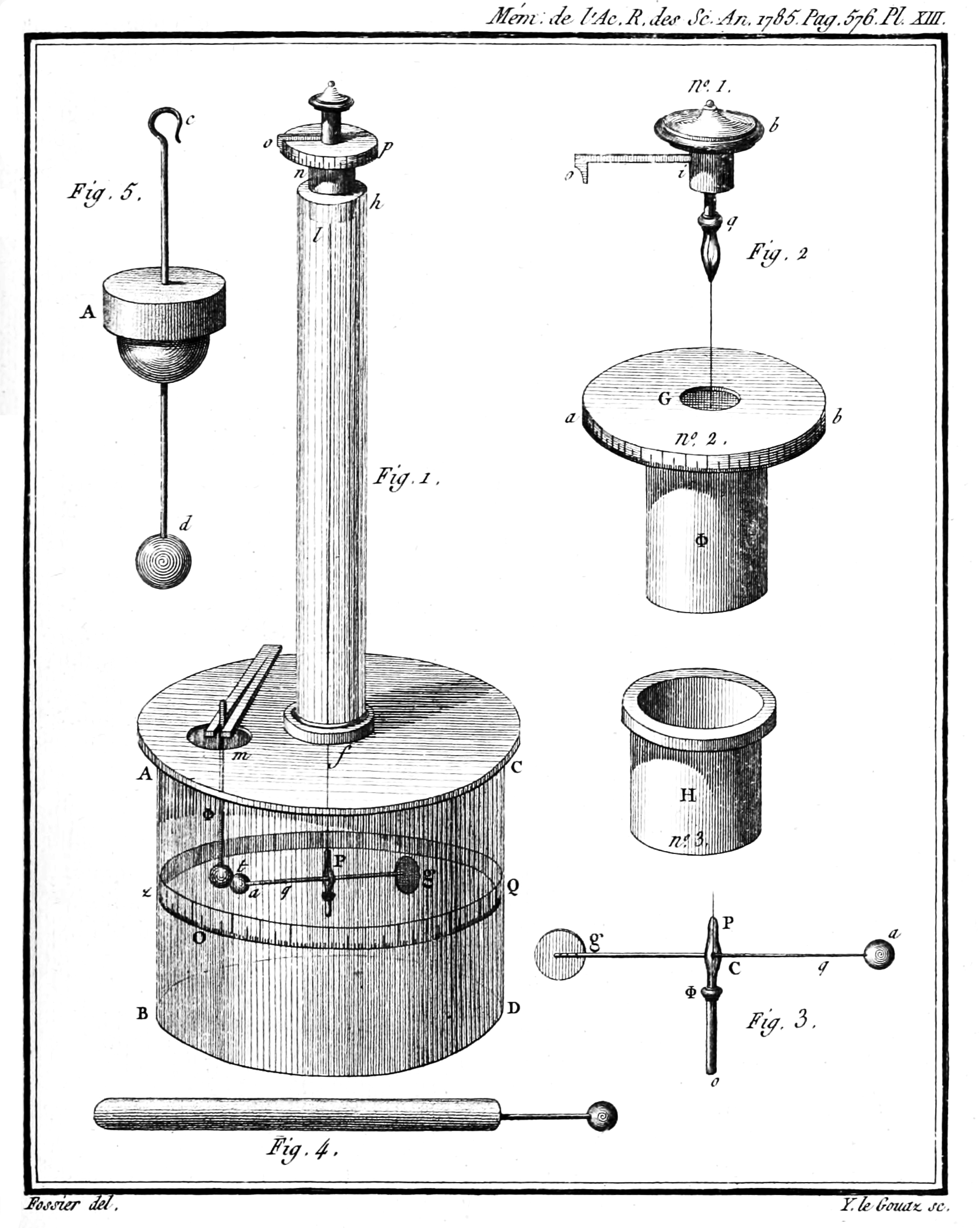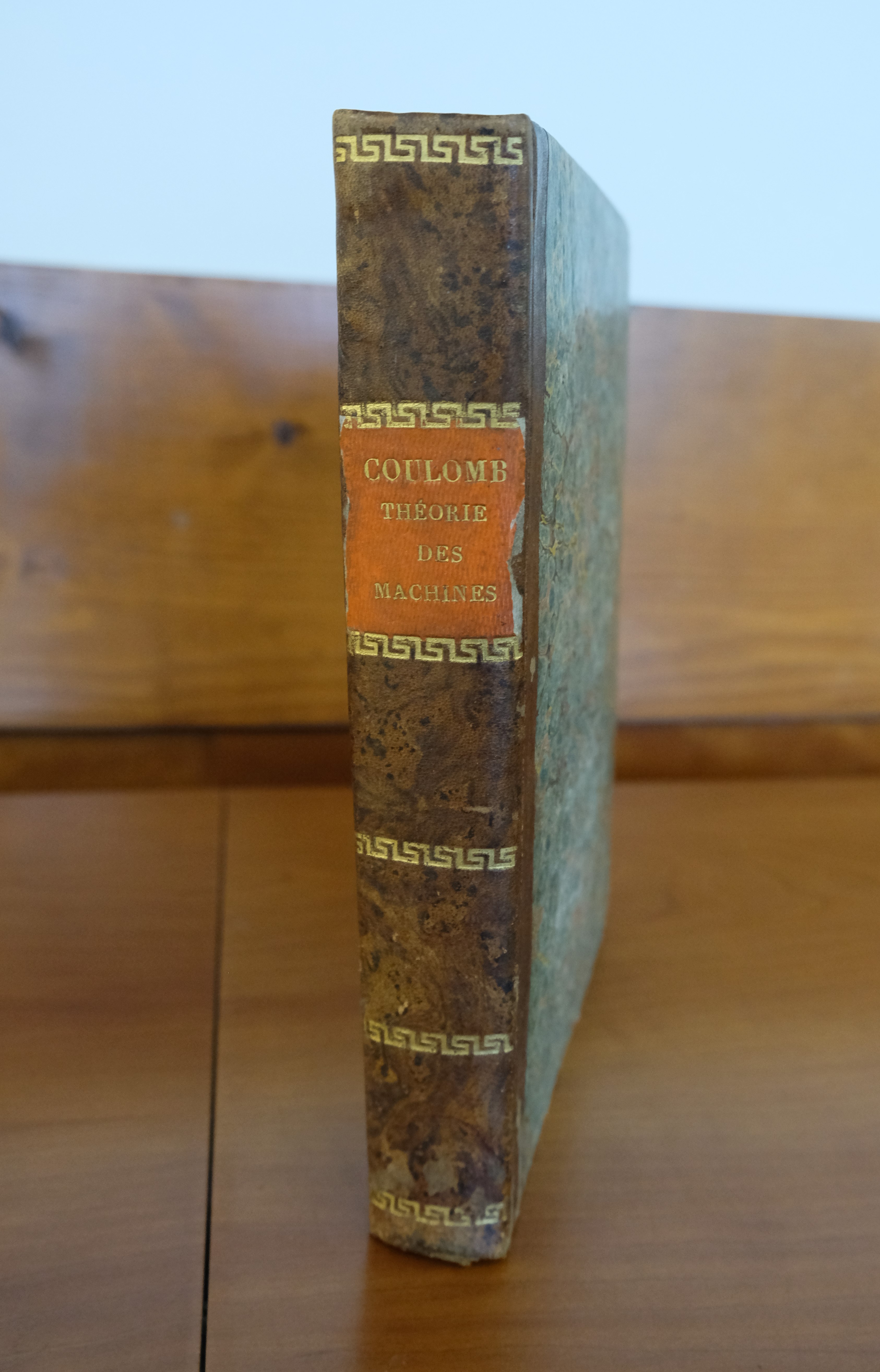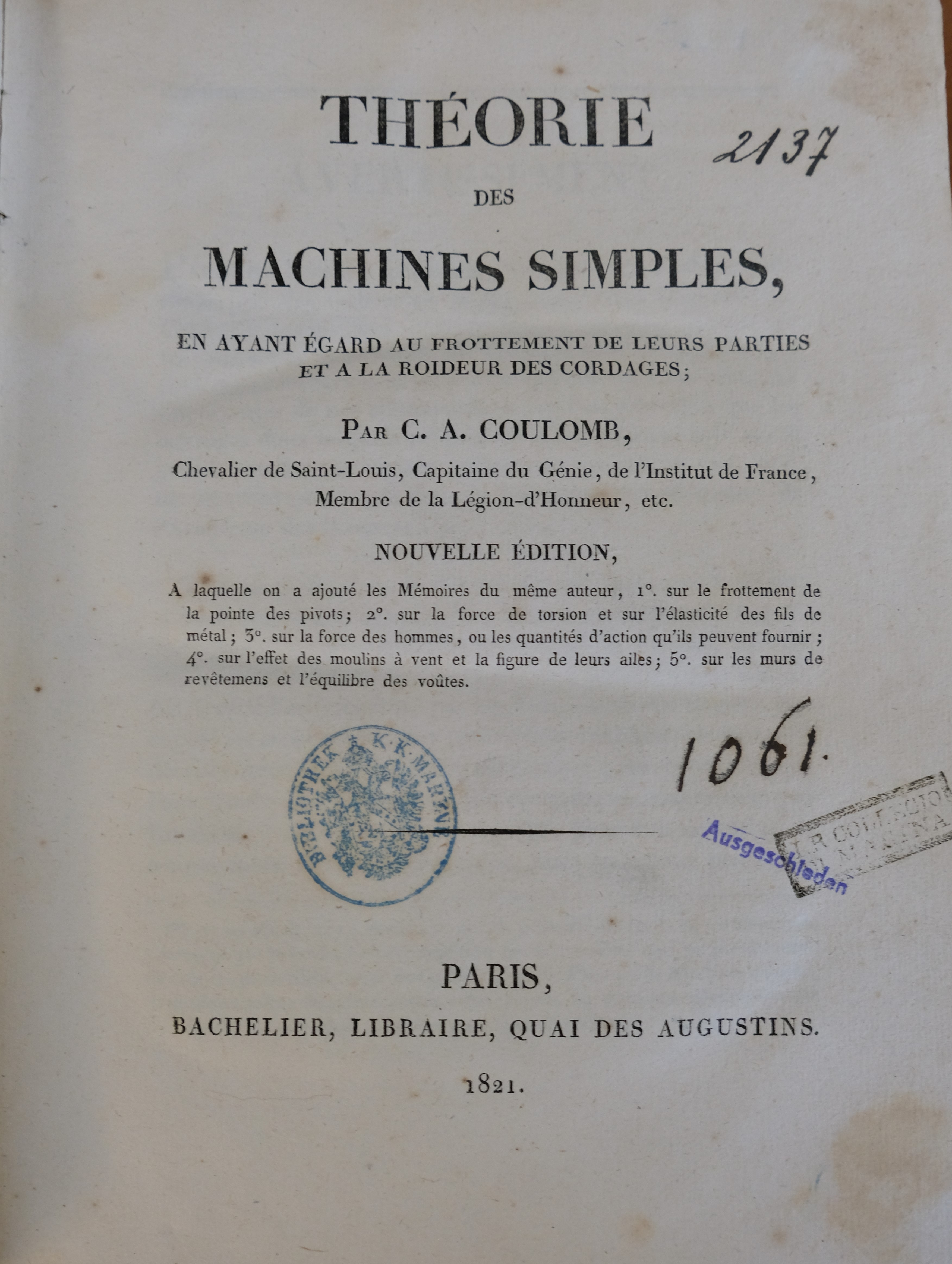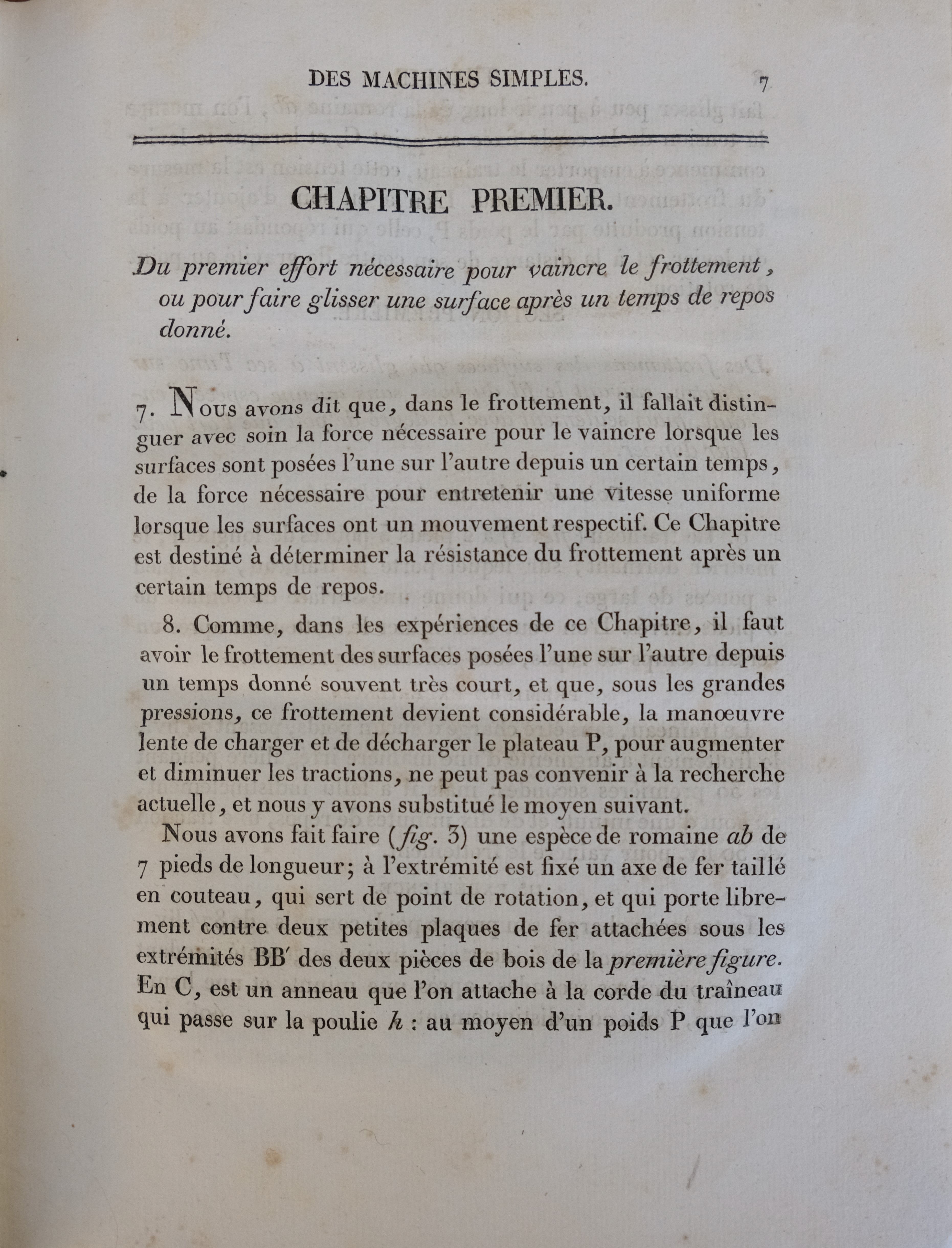1. Overview
Charles-Augustin de Coulomb (Charles-Augustin de CoulombkulɔFrench; June 14, 1736 - August 23, 1806) was a prominent French officer, engineer, and physicist whose groundbreaking work significantly advanced the fields of physics and engineering. He is best known for his pivotal contributions to electrostatics, particularly the formulation of Coulomb's law, which describes the fundamental force of attraction or repulsion between electric charges. This law, derived from his meticulous experiments using a torsion balance, established a quantitative basis for understanding electricity and magnetism.
Beyond his work in electromagnetism, Coulomb made substantial contributions to tribology, the study of friction, where his findings became part of the widely recognized Amontons-Coulomb laws of friction. He also laid foundational principles in geotechnical engineering with his earth pressure theory, which remains relevant in the design of retaining walls. In recognition of his profound impact on science, the SI unit of electric charge, the coulomb, was named in his honor in 1880. His name is also among the 72 names inscribed on the Eiffel Tower, solidifying his legacy as a pioneer in multiple scientific and engineering disciplines.
2. Life
Charles-Augustin de Coulomb's life was marked by a blend of military service, engineering practice, and relentless scientific inquiry, spanning a period of significant political upheaval in France.
2.1. Early Life and Education
Charles-Augustin de Coulomb was born on June 14, 1736, in Angoulême, a county in the Kingdom of France. His father, Henri Coulomb, was an inspector of the royal demesne originally from Montpellier, and his mother, Catherine Bajet, came from a wealthy family involved in wool trade. He was baptized at the parish church of St. André.
Early in his childhood, his family relocated to Paris, where he received his education at the prestigious Collège des Quatre-Nations, also known as Collège Mazarin. There, he studied philosophy, language, literature, and received a strong education in mathematics, astronomy, chemistry, and botany. Under the tutelage of Pierre Charles Monnier in mathematics, he resolved to pursue a career rooted in mathematics and related fields. When his father encountered financial difficulties, Coulomb had to leave Paris and move to Montpellier, where he stayed with his father's family from 1757 to 1759. During this time, he contributed to the local scientific society, working under the guidance of the mathematician Augustin Danyzy. In 1759, with his father's approval, he returned to Paris to prepare for the entrance exams for the École royale du génie de Mézières (Royal School of Military Engineering at Mézières), which he successfully passed in 1760. He graduated from the school in 1761 and joined the French army as an lieutenant engineer.
2.2. Early Military and Engineering Career
For the next two decades, Coulomb was engaged in various engineering assignments across different locations, focusing on structural engineering, fortifications, and soil mechanics. His initial posting was to Brest, but in February 1764, he was dispatched to Martinique in the West Indies. There, he was put in charge of constructing the new Fort Bourbon (now Fort Desaix), a demanding task that occupied him until June 1772. He spent eight years overseeing the construction, during which he also conducted experiments on the durability of masonry and the behavior of supporting structures, inspired by the friction theory of the Dutch scientist Pieter van Musschenbroek. The tropical climate of Martinique negatively impacted his health, an affliction that would affect him for the remainder of his life.
Upon his return to France with the rank of captain, Coulomb was stationed at Bouchain. He began to author significant works on applied mechanics, presenting his first work to the Académie des Sciences in Paris in 1773. In 1779, he was sent to Rochefort to collaborate with the Marquis de Montalembert on the construction of a wooden fort near Île-d'Aix. While in Rochefort, he continued his research in mechanics, utilizing the city's shipyards as laboratories for his experiments. He also held postings in La Rochelle, Île-d'Aix, and Cherbourg. It was during this period that he first observed the inverse square relationship for the force between electric charges and magnetic poles, which would later be formalized as Coulomb's law. Also in 1779, he published an important investigation into the laws of friction, titled Théorie des machines simples, en ayant regard au frottement de leurs parties et à la roideur des cordagesFrench, followed twenty years later by a memoir on fluid resistance.
2.3. Scientific Academy Activities and French Revolution
In 1774, Coulomb became a corresponding member of the French Academy of Sciences. His work on magnetic compasses earned him first prize from the Academy in 1777, and he received another first prize in 1781 for his research on friction. That same year, he was elected a full member of the Academy of Sciences.
By 1781, he was stationed in Paris, his final military posting. In 1787, alongside Jacques-René Tenon, he visited the Royal Naval Hospital in Stonehouse, England, where they were impressed by its revolutionary "pavilion" design and recommended it to the French government. With the outbreak of the French Revolution in 1789, Coulomb resigned from his appointment as intendant des eaux et fontaines (inspector of waters and fountains) and retired to his small estate near Blois, where he continued his experiments.
Despite his retirement, the Revolutionary government recalled him to Paris for a period to participate in the new determination of weights and measures, which would form the basis of the modern metric system. He became one of the first members of the French National Institute and, in 1801, served as its president. In 1802, he was appointed inspector of public instruction. His health was already very frail, and he passed away four years later, on August 23, 1806, in Paris. Coulomb was widely respected during his time not only as a scientific researcher but also as a person of integrity.
3. Major Scientific Contributions
Charles-Augustin de Coulomb's scientific work was characterized by rigorous experimentation and the precise mathematical formulation of physical laws, laying groundwork in multiple domains.
3.1. Torsion Balance
Coulomb's invention and development of the torsion balance were crucial for his experimental breakthroughs, particularly in electromagnetism. In 1784, he published his seminal memoir, Recherches théoriques et expérimentales sur la force de torsion et sur l'élasticité des fils de metalFrench (Theoretical research and experimentation on torsion and the elasticity of metal wire). This work detailed the results of his experiments on the torsional force exerted by metal wires, specifically within the context of a torsion balance.
His general finding was that the moment of the torque applied to a metal wire is, for wires of the same material, proportional to the torsional angle, directly proportional to the fourth power of the wire's diameter, and inversely proportional to the wire's length. This instrument allowed him to measure extremely small forces with unprecedented precision, which was essential for his subsequent investigations into electric and magnetic interactions. The torsion balance became a cornerstone apparatus in experimental physics. It is worth noting that the English geologist John Michell also independently conceived of the torsion balance around 1750, though he did not widely publicize its use for measuring gravitational forces.

3.2. Research on Electricity and Magnetism: Coulomb's Law
Coulomb's most famous contributions lie in his pioneering research in electrostatics and magnetism, culminating in the discovery and formulation of Coulomb's law. Between 1785 and 1789, while working for various government departments, he published a series of seven detailed reports on electricity and magnetism to the French Academy of Sciences.
In 1785, he presented his initial three reports:
- Premier Mémoire sur l'Électricité et le MagnétismeFrench (First Memoir on Electricity and Magnetism): In this paper, Coulomb described how to construct and utilize an electric balance (torsion balance), highlighting its property of metal wires to exert a reaction torsion force proportional to the torsion angle. He experimentally determined the law governing the repulsive force between two similarly charged bodies, stating that "the repulsive force that the two balls electrified with the same kind of electricity exert on each other, follows the inverse proportion of the square of the distance."
- Second Mémoire sur l'Électricité et le MagnétismeFrench (Second Memoir on Electricity and Magnetism): This publication detailed the laws by which both magnetic and electric fluids act, whether through repulsion or attraction. He explicitly stated that the attractive force between two oppositely charged spheres is proportional to the product of their charge quantities and inversely proportional to the square of the distance between them. This precise mathematical relationship is known as Coulomb's Law and bears a striking resemblance to Newton's law of universal gravitation.
- Troisième Mémoire sur l'Électricité et le MagnétismeFrench (Third Memoir on Electricity and Magnetism): This memoir focused on the quantity of electricity an isolated body loses over a certain period, either through contact with less humid air or through its supporting structures, which could be more or less idio-electric.
He followed these with four subsequent reports in the ensuing years:
- Quatrième MémoireFrench (Fourth Memoir, 1786): This paper demonstrated two primary properties of the electric fluid: first, that this fluid does not expand into any object by chemical affinity or elective attraction but divides itself between different objects brought into contact; and second, that in conducting objects, the fluid, once stable, expands only on the surface of the body and does not penetrate its interior.
- Cinquième MémoireFrench (Fifth Memoir, 1787): This report examined how electric fluid divides itself between conducting objects upon contact and its distribution across different parts of the object's surface.
- Sixième MémoireFrench (Sixth Memoir, 1788): A continuation of his research into the distribution of electric fluid among multiple conductors, focusing on determining electric density at various points on the surface of these bodies.
- Septième MémoireFrench (Seventh Memoir, 1789): This final memoir in the series was dedicated to magnetism.
Coulomb successfully explained the laws of attraction and repulsion between electric charges and magnetic poles. However, he did not establish a direct relationship between these two phenomena, believing that the attraction and repulsion were caused by distinct types of "fluids" (the fluid theory of electricity). His meticulous work experimentally verified that both electric and magnetic forces followed an inverse square law.
3.3. Research on Friction and Tribology
Charles-Augustin de Coulomb also made significant and foundational contributions to the field of tribology, the science and engineering of interacting surfaces in relative motion, including the study of friction, wear, and lubrication. In 1779, he published his influential treatise, Théorie des machines simples, en ayant égard au frottement de leurs parties et à la roideur des cordagesFrench (Theory of simple machines, taking into account the friction of their parts and the stiffness of ropes).
This work presented the most comprehensive study of friction undertaken in the eighteenth century. The findings within this memoir, combined with those of Guillaume Amontons, are now widely recognized as the Amontons-Coulomb laws of friction. These laws describe fundamental aspects of dry friction, including that the friction force is proportional to the normal force and largely independent of the apparent contact area. Historian of tribology Duncan Dowson recognized Coulomb as one of the 23 "Men of Tribology" for his profound and lasting impact on the understanding of friction and its practical applications, particularly in machine design and lubrication theory.
3.4. Earth Pressure Theory
Coulomb made groundbreaking contributions to the understanding of lateral earth pressure, which have since become foundational principles in geotechnical engineering. In 1773, he proposed a theory of earth pressure. In 1776, he presented his influential work, Essai sur une application des règles de Maximis et Minimis à quelques Problèmes de Statique, relatifs à l'ArchitectureFrench (Essay on the Application of the Rules of Maxima and Minima to Certain Problems of Statics Related to Architecture), to the Académie des Sciences.
This essay introduced what is now widely known as the wedge theory of earth pressure and established several key principles for systematically analyzing the stability of soil masses, particularly in the context of retaining wall design:
- Shear resistance law: Coulomb formulated the shear resistance of soils, defining it as a function of cohesion and the angle of internal friction. His law states that the shear strength (s) is equal to cohesion (c) plus the normal stress (σ) multiplied by the tangent of the angle of internal friction (φ), expressed as s = c + σ tan φ.
- Active and passive earth pressure: He introduced the concepts of active and passive earth pressure limits. Active earth pressure describes the minimum horizontal pressure exerted by soil on a retaining structure when the soil tends to move away from the structure, while passive earth pressure describes the maximum resistance offered by the soil when the structure pushes against it.
- Failure planes: Coulomb determined that the critical failure plane in soils, along which sliding is most likely to occur, forms an angle of 45 degrees + φ/2 to the horizontal.
- Wall friction: He was among the first to consider the effects of friction between the retaining wall and the soil, recognizing that this friction can significantly reduce the lateral earth pressure exerted on the structure.
- Critical height: Coulomb provided a method to calculate the critical height of vertical soil banks that can remain stable due to their cohesion, before collapsing under their own weight.
- Drainage: He emphasized the crucial role of proper drainage in preventing the accumulation of water, which can create additional hydrostatic forces on retaining structures and compromise their stability.
- Empirical validation: Coulomb validated his theoretical models by comparing them with contemporary construction practices, including those employed in the retaining walls designed by Marshal Vauban, a renowned military engineer.
Coulomb's analysis went beyond the empirical engineering solutions prevalent in his time by systematically applying principles of statics and mechanics to problems of soil stability. His methods, although refined by later researchers, laid the fundamental groundwork for modern soil mechanics and retaining wall design, and they remain relevant in geotechnical engineering today. His contributions not only advanced the theory of soil mechanics but also influenced subsequent works, including those of William John Macquorn Rankine, who further refined theories for cohesive and granular soils. As a testament to the enduring impact of his work, the colophon used in Coulomb's 1776 paper is reproduced on the cover of each edition of the peer-reviewed geotechnical engineering journal Géotechnique.
4. Legacy and Assessment
Charles-Augustin de Coulomb's work left an indelible mark on multiple scientific and engineering disciplines, and his name continues to be honored and recognized.
4.1. Impact on Scientific Development
Coulomb's discoveries profoundly influenced subsequent scientific progress. His experimental verification and mathematical formulation of the inverse square law for electrostatic and magnetic forces provided a quantitative foundation for the emerging field of electromagnetism. Although he did not identify a direct relationship between electricity and magnetism, his meticulous work on the behavior of electric charges and magnetic poles served as a critical precursor for later breakthroughs. For example, his findings on charge distribution and the nature of electric and magnetic forces paved the way for subsequent research by scientists like Hans Christian Ørsted, who discovered the relationship between electricity and magnetism, and André-Marie Ampère, who further developed the field of electrodynamics.
In recognition of his fundamental contributions, the coulomb (C) was officially adopted as the SI unit of electric charge in 1880, a lasting tribute to his name. Beyond electromagnetism, his work on friction, particularly the Amontons-Coulomb laws of friction, provided a systematic understanding of surface interactions that remains central to tribology and mechanical engineering. Furthermore, his pioneering work in earth pressure theory established him as a key figure in the nascent field of geotechnical engineering, with his methods for analyzing soil stability forming the basis for modern retaining wall design and influencing later figures like William John Macquorn Rankine. Coulomb is widely recognized as a pioneer whose rigorous experimental approach and mathematical precision transformed various branches of physics and engineering.
4.2. Theoretical Limitations and Criticisms
While Coulomb's contributions were groundbreaking, certain aspects of his work also presented theoretical limitations. For instance, his understanding of electrical and magnetic phenomena was based on a "fluid theory," where he posited the existence of separate electric and magnetic fluids responsible for attraction and repulsion. This conceptual framework, while useful for describing his experimental results, did not fully capture the unified nature of electromagnetism that would later be understood.
Another notable point is the independent discovery of the inverse square law of electrostatics by Henry Cavendish (1731-1810). Cavendish conducted similar experiments using a different method in the 1770s, but his findings were not published during his lifetime. His work remained unknown until 1879, long after Coulomb had published his own results and established his law. Consequently, the credit for the discovery of the fundamental law governing electrostatic forces was universally attributed to Coulomb.
4.3. Commemoration and Honors
Charles-Augustin de Coulomb's enduring legacy is celebrated through various commemorations and honors. His name is prominently inscribed on the Eiffel Tower in Paris, a tribute to his significant contributions to French science and engineering.


Additionally, a tangible representation of his engineering foresight is seen in the continued relevance of his work on earth pressure. The very design of the retaining walls at Fort Bourbon in Martinique, which he supervised, stands as a testament to his practical and theoretical expertise. The colophon from his 1776 paper on earth pressure, Essai sur une application des règles de Maximis et Minimis à quelques Problèmes de Statique, relatifs à l'Architecture, is featured on the cover of every edition of the highly respected geotechnical engineering journal Géotechnique, signifying his foundational role in the field.

5. See also
- Coulomb's law
- Coulomb
- Friction
- Torsion balance
- List of things named after Charles-Augustin de Coulomb
- List of scientists whose names are used in physical constants
- Lateral earth pressure